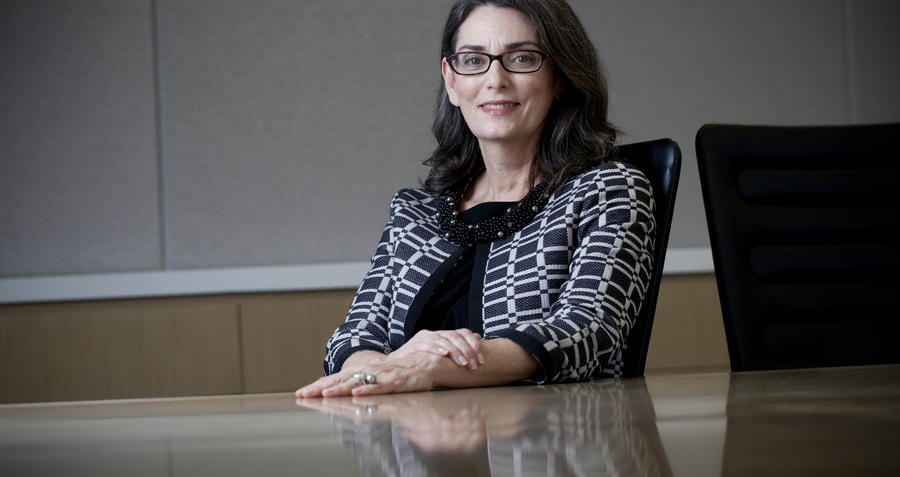
Our Group Managing Director Catherine Tanna addresses the AFR National Energy Summit with a message that energy is stuck.
Good morning.
I acknowledge we are meeting today on the traditional country of the Gadigal people of the Eora Nation.
I recognise and respect their continuous living culture and connection to country and pay my respect to their elders, past, present and future.
Thank you for inviting me back; the Energy Summit is a great event.
The timing couldn’t be better, right on the heels of our football seasons. Footy fans are passionate … but the heat in the national energy debate is something else entirely.
I wonder what the debate looks like to people outside the energy industry – to a family trying to get by, to keep the kids happy and pay the bills.
Most often they’re presented with two extremes: on one hand a drive for the endless build of new renewable energy …
… versus stoic support for old coal on the other…
A thoughtful transition, playing on the strengths of both those fuels, is hardly ever put as an option.
Last year, I pitched to you a five-point plan to get energy back on track:
- Drop the “big stick” rhetoric
- Commit to a national energy framework
- Send the right signals for industry to build the assets we need
- Lift the bans and go-slows on gas development, and
- Trust the experts at our independent regulators, to do their jobs
I haven’t got a new plan for you; I still think the old one is a good one.
But there is something more fundamental to solve for…
Energy is stuck.
Everyone is shouting… And everyone is right, because everyone is talking about different things.
It’s like being in a bar just before closing time.
That feels wrong.
If we’re to get anywhere, this tribalism and pursuit of people to blame must stop.
Energy is far from the first issue of national importance to divide the country.
Our great rail network was begun before federation. Each colony adopted what it thought was the right rail gauge; narrow, standard or broad.
That worked …
… until federation, when trade between states opened, and the rail lines stopped at the border…
It took 90 years to fix. Then, just like now, families and businesses paid for missteps and delay.
Everyone was right, until they weren’t.
The frustrating thing about energy is we agree on more than we realise.
Decarbonisation of our energy system and the economy is inevitable.
It isn’t whether we’ll get to net zero-emissions, it’s when and it’s how.
And how isn’t exclusively about the technology. It also goes to fairness…
…it’s whether the clean energy transition will work for everyone in Australia, no matter where they live or how much they earn.
Will we make energy cleaner, reliable and affordable for all? Or will people get left behind?
The path has already been bumpier than it should have been.
Let’s review…
Almost six years ago I swapped a career in upstream oil and gas and joined EnergyAustralia.
My friends made a swift, unsolicited diagnosis of my mental health: They said I was mad.
The reason might surprise you. It was because in 2014 electricity retailing was boring.
Yes, the good old days…
Back then, energy companies were actually harnessing public apathy in clever marketing.
A forerunner of EnergyAustralia had an advertisement that went like this:
“We’re excited about electricity and gas – even if you’re not…”
By 2014 our ads had moved on, but the sentiment remained.
Then, the big problem was too much electricity. It sounds absurd today.
Network costs, green scheme costs and retail costs were pushing up household bills.
But there were few signs of life in the wholesale electricity market. Demand-growth for electricity had stalled, as heavy industry contracted, and installations of roof-top solar systems surged.
One of the first announcements I made at EnergyAustralia was a painful one: the retirement of the Wallerawang power station near Lithgow, after 40-years’ service.
The plant was too costly to maintain in a depressed market.
Closing Wallerawang did reduce emissions; it was the rough equivalent of taking 2 million cars a year off the road…
…but it also cost local jobs.
Even afterwards, EnergyAustralia was struggling financially.
Your superfund might make an annual return of, say, 7- to 10 per cent; EnergyAustralia was making half that – in a good year.
From 2006 to 2014 the company lost around $200 million and had to write-off some $1.9 billion from the value of its assets.
In my first two years at EnergyAustralia we cut or made significant changes to almost 500 roles.
We re-set our priorities. Until then, we generated electricity and tried to find a home for it.
Under our new strategy we serve the customer first.
Bit by bit our service and results were improving.
We didn’t get everything right; we still don’t, even after years of concerted effort.
We are in a constant struggle to manage the velocity – the volume and complexity – of change to rules, regulations and the energy system.
But we were heading in the right direction.
As we got toward the last days of 2016 the Oxford Dictionary sounded an ominous warning for the energy industry with its word of the year…
…an Orwellian-sounding adjective, post-truth …
It defined post-truth as …
… “relating to … circumstances in which objective facts are less influential in shaping public opinion than appeals to emotion and personal belief”.
Post-truth seemed made for the times, when our news was dominated by the Brexit referendum and the US presidential elections.
Then in early 2017 an ageing power plant in Victoria called Hazelwood closed.
Even though Hazelwood’s retirement was inevitable and long predicted, it caught industry and government off guard.
The country’s capacity to generate reliable power contracted sharply.
The wholesale market tightened. There was a massive shock to the system and customers’ wallets.
For some households, average annual electricity bills increased by 20 per cent.
That was on top of all the other bills our customers had piling up on their kitchen counters.
Amidst it all, there were “affordable energy pledges” and PM’s roundtables; big sticks were flourished in parliament.
There was the mother of all stand-offs between a private company and a national government over the future of a New South Wales coal-fired power station of pensionable age.
Governments doubled-down on a renewable energy arms race.
Electricity prices were partially re-regulated through default safety nets.
Memories of the lights going out in South Australia cast a shadow over everything.
Renewables weren’t the problem. But renewables were the problem.
The system wasn’t ready.
An electron is an electron; it behaves the same whether it’s generated by burning coal or the wind turning a giant blade.
But everyone was still learning a new technology, one that put new demands on a system built for another time.
The world has changed; making wind and solar available 24/7 is one of the challenges we must solve.
At EnergyAustralia we also changed.
In 2018 we committed to investing more than $320 million to help support customers and modernise the country’s power system.
That included around $70 million to mitigate, reduce or avoid electricity price rises for families and vulnerable customers.
For almost two years, prices for an average EnergyAustralia customer were flat, or down.
We already underpin more than 800 megawatts of new wind and solar projects and we operate the largest battery trading portfolio in the National Electricity Market.
Now, we’re working on pumped hydro, gas-fired generation and energy recovery projects to increase supplies of reliable power.
But if Twitter was your universe, you might believe EnergyAustralia was either a colossal environmental vandal or we were bent on inflicting economic ruin via mad green schemes.
It depends on the day you check your feed.
I can understand the basis for some of the criticism:
- After all, EnergyAustralia is a big generator of power from fossil fuels. Each year we produce around 22 million tonnes of greenhouse gases to supply electricity to our 1.7 million customers.
- We also have one of the largest renewable energy portfolios in Australia. We have committed to buying around $3 billion worth of renewable energy under long-term contracts.
I tell you this not because we’re special, or so you feel sorry for us and the mean people on social media stop throwing stones at us.
I tell you this because it’s happening to everyone in the energy debate.
If you agree with me, you’re going to heaven; if not, it’s the other place.
I love this quote:
“Don’t raise your voice. Improve your argument.”
It’s attributed to Archbishop Desmond Tutu.
Even so, there are social science studies which suggest the better educated a person, the better they are at seeking and finding information that confirms their views.
So, what’s to be done?
We already have most of the puzzle pieces for a modern, cleaner energy system: it looks like solar, wind, demand response, pumped hydro, battery storage and intelligent energy management, supported by gas-fired generation.
We know we need an energy market that rewards flexible and dispatchable energy ... a market that encourages investment before there’s a generation shortfall, and one that places risk with the private sector, and not households or taxpayers.
Between the 106 recommendations made by the Finkel panel and the ACCC, the blueprint for fixing energy exists.
Technical engineering isn’t the problem. The challenge is putting all the pieces together to create a whole that’s affordable, simple and fair for customers.
If the transition to a modern, cleaner energy system doesn’t work for families and communities, it will take longer and cost more than it needs to.
We must get better at managing the retirements of big power stations. There might be a dozen in the next 30 years.
If replacement capacity isn’t ready to go, and we haven’t planned to manage impacts on communities, we will repeat Hazelwood.
Customers have paid for us to learn those lessons.
Now, the stakes are even higher: when Hazelwood shut, we lost the slack in the system.
Today, there is no margin for error.
Planning is a test for any company or public body. It’s hard, it’s exhausting and when it goes well it’s thankless, because a well-executed plan is smooth, so no one notices.
But planning is impossible when everyone thinks they’re right and no one is listening.
If we’re not prepared to compromise, the alternative solution is absolute power, and there is a high cost to that battle.
Perhaps our biggest obstacle is how we bridge the chasm that separates us, and the people with whom we disagree – us and them.
Fortunately, we do believe many of the same things:
- Most people agree electricity prices must come down.
- Most people agree emissions must come down.
- Most people agree power system reliability is not negotiable.
Modernising our energy system is a far more complex proposition than cheering for our footy team.
But surely, when so many people agree on such fundamental truths, energy can be fixed.
So:
- Who’ll drop the partisan lines, the point-scoring and the posturing?
- Who’ll show they understand that coal will go – but not tomorrow?
- Who’ll accept that renewables will underpin a modern energy system – but they need to be made firm, and that there will be a cost?
We have some wonderful advantages, not least the smart, capable people in our companies and regulators who want the opportunity to build a modern energy system, because energy matters.
And we can be proud that our country has the drive, the passion and the courage to make the transition to a modern, cleaner energy system.
Energy is many things; it’s exciting, it’s essential and it’s frustrating.
But it is certainly not boring.
And it can be fixed.
Thank you.


